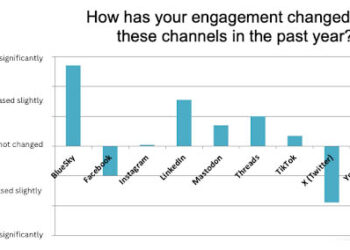 Image via Wikipedia
Image via Wikipedia An interesting post on Scott Karp’s Publishing 2.0 site explores the power of linking in an important way. Basically, Scott finds that the Drudge Report, which is full of links, does better on many metrics than more traditional news sites. His conclusion is that by sending people away, a site guarantees that they will come back.
This seemingly counterintuitive finding is pure Web 2.0, and the examples to demonstrate its essential accuracy are many. For instance, Google itself is just a set of changing links generated by typing in a keyword. Blogs are content management systems that store links along with content as part of their value equation, so that blogs become starting points for people (look at how many links are in this blog entry!). iGoogle is just a set of feed links, yet has grown into a major online hub and source of audience to sites that provide gadgets and the like for users. Netvibes is just a linking hub site, as well.
The possibility of editorial value-add around links is often missed by traditional publishers, yet Yahoo! understands it. Yahoo!’s news sections change many times per day, and are likely a major reason people return.
Another company that “gets it” is Newstex. I was able to see the CEO speak at the recent ASIDIC meeting in Salem, MA. By aggregating content feeds and linking out, Newstex has a powerful, modern publishing approach that leverages the new bargains of online publishing in a pure and effective manner. I’ll be watching them with interest.
Too many publishers (and authors and editors) still intuitively believe that content is king. They think the best content rises to the top of search results. Guess what? The royal model doesn’t work, especially on the social web. Instead, it’s a commerce model on the social web. Links are the fungible currency users transact to generate the Web’s GDP.
(In an odd demonstration that links equate to power, see the recent story of the mayor of Sheboygan suing a woman for linking to the city’s police department web site.)
Users feel rich when they have a lot of links to spend, and poor when they don’t. Users return to where the money is. And that’s how wealth is created online, I think.
Discussion
1 Thought on "Go Away = Come Back"
Kent,
Outlinks (that is, a link from your site to another) performs a functional purpose which is moving potential readers away from your own content. But outlinks also perform a semantic function, which is to identify those sites which are hubs and those sites which are authorities.
Hubs are sites that link out to many other sites (imagine a directory), and authorities are sites that receive a lot of these inlinks. Both kinds of sites are useful for obvious reasons, and in calculating the value of each site, search algorithms use an iterative process whereby value is transferred back and forth from the hubs and authorities — the hubs giving value to the authorities, and the authorities (by virtue of their number of inlinks) transfering some of it back to the hubs.
Web design in the 1990s focused on bringing people to your site and keeping them there. Today’s sites focus on creating relevance by connecting themselves with authoritative sites. Given a new method of creating relevance and value, people would adopt different linking behaviors.
Below is a reference to a short and very readable article on this topic:
—-
Kleinberg, J. M. 1999. Hubs, Authorities, and Communities. ACM Computing Surveys 31. http://www.cs.brown.edu/memex/ACM_HypertextTestbed/papers/10.html
![Reblog this post [with Zemanta]](http://img.zemanta.com/reblog_e.png?x-id=239e5b5a-1e01-419a-a968-3b9f35fd1382)


